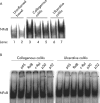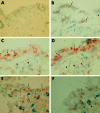Activation of nuclear factor kappaB in colonic mucosa from patients with collagenous and ulcerative colitis
- PMID: 15753535
- PMCID: PMC1774469
- DOI: 10.1136/gut.2003.034165
Activation of nuclear factor kappaB in colonic mucosa from patients with collagenous and ulcerative colitis
Abstract
Background and aims: Expression of inducible nitric oxide synthase (iNOS) is greatly upregulated in the colonic mucosa of patients with collagenous and ulcerative colitis. As the transcription factor nuclear factor kappaB (NFkappaB) is a major inducer of iNOS gene expression, we compared activation and transcriptional activity of NFkappaB in colonic mucosal biopsies from these patients.
Patients: Eight patients with collagenous colitis, six with relapsing ulcerative colitis, and eight with uninflamed bowel were studied.
Methods: NFkappaB DNA binding activity was assessed by electrophoretic mobility shift assay and inhibitor of NFkappaB (IkappaB) kinase (IKK) activity by immunocomplex kinase assay. In vivo recruitment of NFkappaB to the iNOS promoter was determined by chromatin immunoprecipitation analysis and transcriptional activity by NFkappaB gene expression profiling arrays. Cells showing NFkappaB activation were identified by immunohistochemistry.
Results: In collagenous and ulcerative colitis, as opposed to uninflamed bowel, IKKbeta activity and strong NFkappaB DNA binding gave rise to activation of identical NFkappaB subunits and recruitment of transcriptionally active p65 to the iNOS promoter. In collagenous colitis, activated NFkappaB was observed only in epithelial cells while up to 10% of lamina propria macrophages showed activation in ulcerative colitis.
Conclusions: In collagenous and ulcerative colitis, colonic mucosal NFkappaB is activated and recruited to the iNOS promoter in vivo via an IKKbeta mediated pathway. As collagenous colitis is not associated with tissue injury, these data challenge the prevailing view that activation of NFkappaB per se mediates tissue injury. Our results suggest that downstream inflammatory reactions leading to tissue damage originate in lamina propria immune cells, as increased NFkappaB activity in collagenous colitis was localised solely in epithelial cells, but present also in macrophages in ulcerative colitis.
Figures





Comment in
-
The complicated path to true causes of disease: role of nuclear factor kappaB in inflammatory bowel disease.Gut. 2005 Apr;54(4):444-5. doi: 10.1136/gut.2004.051797. Gut. 2005. PMID: 15753521 Free PMC article. No abstract available.
References
-
- Perner A, Nordgaard I, Matzen P, et al. Colonic production of nitric oxide gas in ulcerative colitis, collagenous colitis and uninflamed bowel. Scand J Gastroenterol 2002;37:183–8. - PubMed
-
- Järnerot G, Tysk C, Bohr J, et al. Collagenous colitis and fecal stream diversion. Gastroenterology 1995;109:449–55. - PubMed
-
- Taylor BS, de Vera ME, Ganster RW, et al. Multiple NF-kappaB enhancer elements regulate cytokine induction of the human inducible nitric oxide synthase gene. J Biol Chem 1998;273:15148–56. - PubMed
-
- Taylor BS, Shao L, Gambotto A, et al. Inhibition of cytokine-induced nitric oxide synthase expression by gene transfer of adenoviral I kappa B alpha. Surgery 1999;126:142–7. - PubMed
Publication types
MeSH terms
Substances
LinkOut - more resources
Full Text Sources
Other Literature Sources
Medical
Research Materials
Miscellaneous
